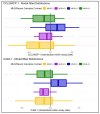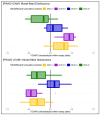Cannabis Use Moderates Methamphetamine- and HIV-Related Inflammation: Evidence from Human Plasma Markers
- PMID: 40872856
- PMCID: PMC12390692
- DOI: 10.3390/v17081143
Cannabis Use Moderates Methamphetamine- and HIV-Related Inflammation: Evidence from Human Plasma Markers
Abstract
Background: Methamphetamine use, which is disproportionately prevalent among people with HIV, increases risk for cardio- and neurovascular pathology through persistent immune activation and inflammation. Preclinical studies indicate that cannabinoids may reduce markers of pro-inflammatory processes, but data from people with chronic inflammatory conditions are limited. We examined potentially interacting associations of lifetime methamphetamine use disorder (MUD), recent cannabis use, and HIV with four plasma markers of immune and inflammatory functions.
Method: Participants with HIV (PWH, n = 86) and without HIV (PWoH, n = 148) provided urine and blood samples and completed neuromedical, psychiatric, and substance use assessments. Generalized linear models examined main and conditional associations of lifetime MUD, past-month cannabis use, and HIV with plasma concentrations of CXCL10/IP-10, CCL2/MCP-1, ICAM-1, and VCAM-1.
Results: PWH displayed higher CXCL10/IP-10 than PWoH. Past-month cannabis use was independently associated with lower CXCL10/IP-10 levels and conditionally lower CCL2/MCP-1, ICAM-1, and VCAM-1 levels among people with lifetime MUD, but only PWoH displayed cannabis-associated lower VCAM-1 levels.
Conclusions: Human plasma sample evidence suggests that cannabis use is associated with lower levels of immune and inflammatory molecules in the context of MUD or HIV. Cannabinoid pathways may be worthwhile clinical targets for treating sequelae of chronic inflammatory conditions.
Keywords: HIV; cannabinoids; central nervous system stimulant; inflammatory signaling pathways; methamphetamine; polysubstance use; substance use disorder.
Conflict of interest statement
The authors declare no conflicts of interest and that funders had no role in the design of the study; in the collection, analyses, or interpretation of data; in the writing of the manuscript; or in the decision to publish the results.
Figures




Similar articles
-
Changes in Immune-Related Biomarkers and Endocannabinoids as a Function of Frequency of Cannabis Use in People Living With and Without HIV.Cannabis Cannabinoid Res. 2024 Jun;9(3):e897-e906. doi: 10.1089/can.2022.0287. Epub 2023 Apr 20. Cannabis Cannabinoid Res. 2024. PMID: 37093248 Free PMC article.
-
Cannabis Use and Biomarkers of Inflammation, Immune Activation, and Microbial Translocation in Persons with HIV.Cannabis Cannabinoid Res. 2024 Dec;9(6):e1579-e1587. doi: 10.1089/can.2023.0109. Epub 2024 Feb 9. Cannabis Cannabinoid Res. 2024. PMID: 38335314
-
Elevated Biomarkers of Inflammation and Vascular Dysfunction Are Associated with Distal Sensory Polyneuropathy in People with HIV.Int J Mol Sci. 2024 Apr 11;25(8):4245. doi: 10.3390/ijms25084245. Int J Mol Sci. 2024. PMID: 38673830 Free PMC article.
-
Cannabis and schizophrenia.Cochrane Database Syst Rev. 2014 Oct 14;2014(10):CD004837. doi: 10.1002/14651858.CD004837.pub3. Cochrane Database Syst Rev. 2014. PMID: 25314586 Free PMC article.
-
The medical use of cannabis for reducing morbidity and mortality in patients with HIV/AIDS.Cochrane Database Syst Rev. 2013 Apr 30;2013(4):CD005175. doi: 10.1002/14651858.CD005175.pub3. Cochrane Database Syst Rev. 2013. PMID: 23633327 Free PMC article.
References
-
- Gan H., Zhao Y., Jiang H., Zhu Y., Chen T., Tan H., Zhong N., Du J., Zhao M. A Research of Methamphetamine Induced Psychosis in 1,430 Individuals with Methamphetamine Use Disorder: Clinical Features and Possible Risk Factors. Front. Psychiatry. 2018;9:551. doi: 10.3389/fpsyt.2018.00551. - DOI - PMC - PubMed
MeSH terms
Substances
Grants and funding
LinkOut - more resources
Full Text Sources
Medical
Miscellaneous

